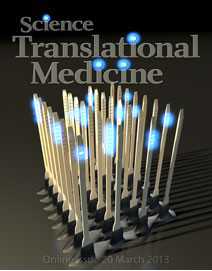Sci Transl Med:新的抗疟药可帮助抵抗耐药性
2013-03-25 EurekAlert! EurekAlert! 发表于上海
耐药性已经在各地达到了危机的水平,但其对疟疾治疗的影响却是极具破坏性的。由蚊子传播的寄生虫恶性疟原虫会引起最致命的疟疾形式,它已经对药品库中的每种药物产生了抵抗力。每年有数百万人不断地死于疟疾。 近日,刊登在国际杂志Sci Transl Med上的一篇研究报告中,Aaron Nilsen及其同事发现了一种叫做ELQ-300的新药,它能够将疟原虫生命周期的多个阶段作为标靶,并能显著地增强对该疾病的
耐药性已经在各地达到了危机的水平,但其对疟疾治疗的影响却是极具破坏性的。由蚊子传播的寄生虫恶性疟原虫会引起最致命的疟疾形式,它已经对药品库中的每种药物产生了抵抗力。每年有数百万人不断地死于疟疾。
近日,刊登在国际杂志Sci Transl Med上的一篇研究报告中,Aaron Nilsen及其同事发现了一种叫做ELQ-300的新药,它能够将疟原虫生命周期的多个阶段作为标靶,并能显著地增强对该疾病的预防、治疗和传播控制。研究人员在小鼠中展示,这种化合物有能力杀死处于所有阶段的寄生虫,其中包括在肝期的疟原虫。该药是通过将疟原虫的线粒体作为标靶而起作用的。疟原虫体内线粒体的主要功能是生产制造DNA所需的构建模块。ELQ-300能够完全地阻断这一过程。
研究人员还发现,ELQ-300在治疗小鼠疟疾时比阿托伐醌的功效强30倍,阿托伐醌是一个目前在临床中使用的药物。在比通常所用剂量低10倍时,该药可完全保护了小鼠免于受到蚊虫传播的感染。文章的作者指出,用传统的方法似乎非常难以选出对ELQ-300耐药的寄生虫。这些结果提示,如果ELQ-300最终被研发成人类用药时,该药在耐药株出现之前可享有长久的临床寿命。在ELQ-300能够进入人类的临床试验之前,它必须还要接受严格的安全性测试。该药可能会被研磨成很细的晶体或纳米颗粒以增强其被吸收进入血液的能力。
与耐药相关的拓展阅读:
doi:10.1126/scitranslmed.3005029
PMC:
PMID:
Quinolone-3-Diarylethers: A New Class of Antimalarial Drug
Aaron Nilsen1,*, Alexis N. LaCrue2,*, Karen L. White3, Isaac P. Forquer1, R. Matthew Cross4, Jutta Marfurt5, Michael W. Mather6, Michael J. Delves7, David M. Shackleford3, Fabian E. Saenz2,†, Joanne M. Morrisey6, Jessica Steuten3, Tina Mutka2, Yuexin Li1, Grennady Wirjanata5, Eileen Ryan3, Sandra Duffy8, Jane Xu Kelly1, Boni F. Sebayang9, Anne-Marie Zeeman10, Rintis Noviyanti9, Robert E. Sinden7, Clemens H. M. Kocken10, Ric N. Price5,11, Vicky M. Avery8, Iñigo Angulo-Barturen12, María Belén Jiménez-Díaz12, Santiago Ferrer12, Esperanza Herreros12, Laura M. Sanz12, Francisco-Javier Gamo12, Ian Bathurst13, Jeremy N. Burrows13, Peter Siegl14, R. Kiplin Guy15, Rolf W. Winter1, Akhil B. Vaidya6, Susan A. Charman3, Dennis E. Kyle2, Roman Manetsch4,‡ and Michael K. Riscoe1,16,‡
The goal for developing new antimalarial drugs is to find a molecule that can target multiple stages of the parasite’s life cycle, thus impacting prevention, treatment, and transmission of the disease. The 4(1H)-quinolone-3-diarylethers are selective potent inhibitors of the parasite’s mitochondrial cytochrome bc1 complex. These compounds are highly active against the human malaria parasites Plasmodium falciparum and Plasmodium vivax. They target both the liver and blood stages of the parasite as well as the forms that are crucial for disease transmission, that is, the gametocytes, the zygote, the ookinete, and the oocyst. Selected as a preclinical candidate, ELQ-300 has good oral bioavailability at efficacious doses in mice, is metabolically stable, and is highly active in blocking transmission in rodent models of malaria. Given its predicted low dose in patients and its predicted long half-life, ELQ-300 has potential as a new drug for the treatment, prevention, and, ultimately, eradication of human malaria.
本网站所有内容来源注明为“梅斯医学”或“MedSci原创”的文字、图片和音视频资料,版权均属于梅斯医学所有。非经授权,任何媒体、网站或个人不得转载,授权转载时须注明来源为“梅斯医学”。其它来源的文章系转载文章,或“梅斯号”自媒体发布的文章,仅系出于传递更多信息之目的,本站仅负责审核内容合规,其内容不代表本站立场,本站不负责内容的准确性和版权。如果存在侵权、或不希望被转载的媒体或个人可与我们联系,我们将立即进行删除处理。
在此留言










精彩评论,需要您登录查看
84
#TRA#
67
#Transl#
73
#Med#
50